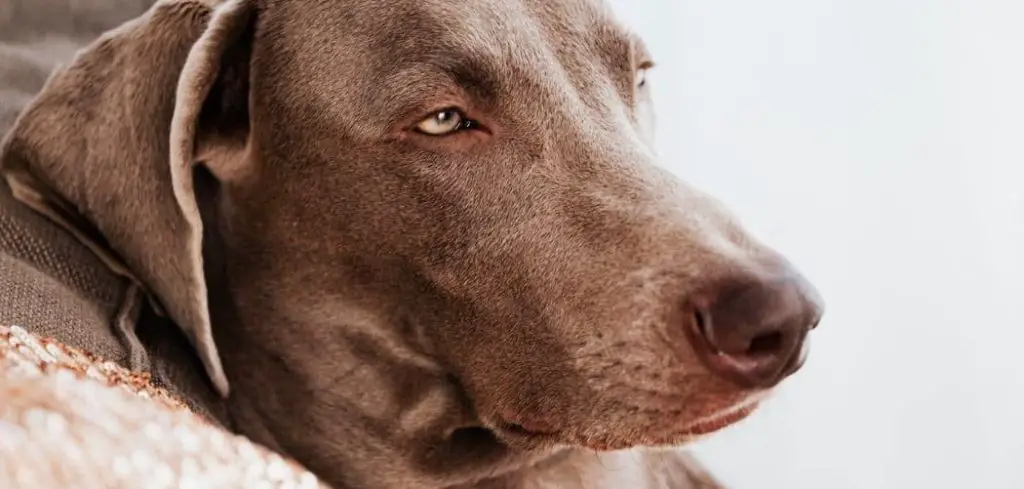It’s unsettling to notice your dog is lethargic, not eating, but still drinking water.
You might feel a bit relieved that they’re staying hydrated—but the lack of appetite and low energy are signs something is off.
Understanding why your dog is acting this way can help you respond quickly and appropriately.
We outline the possible causes and how to determine whether your dog needs home care or a vet visit.
Table of Contents
Dog Lethargic Not Eating but Drinking: Why It Happens
When your dog is lethargic not eating but drinking, the most common causes include nausea, pain, early infection, stress, dental disease, organ dysfunction, or recovery from strenuous activity. While drinking water may suggest your dog isn’t fully dehydrated, the refusal to eat and unusual tiredness should not be overlooked.

Dog Lethargic Not Eating but Drinking: Common Causes
Nausea or Digestive Upset
One of the leading reasons a dog won’t eat but continues to drink is nausea. This could stem from:
Eating something they shouldn’t
A sudden diet change
A mild GI infection
Even mild nausea can make dogs turn away from food while still sipping water.
Other signs might include lip licking, grass eating, drooling, or a gurgling stomach.
If the nausea passes within 24 hours, it may not be cause for alarm. But prolonged refusal to eat or additional symptoms like vomiting warrant a vet visit.
Dental Pain or Oral Discomfort
Dental problems such as broken teeth, gum disease, or mouth ulcers often lead to appetite loss.
Drinking remains tolerable because it doesn’t require chewing.
If your dog is lethargic not eating but drinking, check for:
Bad breath
Pawing at the mouth
Dropping food
Red or swollen gums
Dental issues are painful and can escalate without treatment.
A vet can examine the mouth and recommend proper care, which may include a dental cleaning or antibiotics.
Related: My dog is lethargic and not eating (Causes and when to worry)
Early Stage Infection or Illness
Infections often start subtly, with dogs feeling off before obvious symptoms appear.
A dog may become quiet, uninterested in food, but still maintain normal hydration.
Potential culprits include:
Viral infections (like kennel cough or canine flu)
Tick-borne diseases
Urinary tract infections
If your dog’s energy continues to drop, or additional symptoms emerge—such as fever, sneezing, or vomiting—your vet may run tests to pinpoint the cause.
Stress, Anxiety, or Depression
Dogs are sensitive to emotional shifts. A move, a new pet, recent travel, or the loss of a companion can lead to a decrease in appetite and energy.
These dogs might:
Avoid play or interaction
Sleep more
Seem withdrawn
They may still drink water and even follow you around, but not engage like usual.
If no physical illness is found, your vet may suggest calming tools like pheromone diffusers, routine reinforcement, or behavioral support.
Pain or Internal Discomfort
Dogs experiencing pain—whether from arthritis, muscle strains, or internal issues—may refuse food but continue drinking water to stay hydrated.
Signs of pain include:
Whining or restlessness
Reluctance to move
Hunched posture
Hiding or guarding behavior
Pain can be difficult to detect, especially in stoic breeds.
If your dog is older or recently active, don’t rule out orthopedic pain as a cause of their lethargy.
Kidney or Liver Problems
Both the liver and kidneys play key roles in processing waste and regulating digestion.
When these organs aren’t functioning properly, dogs may feel nauseous or weak—leading to loss of appetite but increased thirst.
Warning signs may include:
Vomiting or diarrhea
Weight loss
Pale gums or yellowing eyes
Urinating more or less than usual
Bloodwork is the only way to confirm organ-related issues. If your dog’s drinking but not eating persists for more than a day, call your vet.
Post-Exercise or Heat Exhaustion Recovery
After intense activity or exposure to heat, some dogs may rest more than usual, lose interest in food, and only want water.
This is more common in active breeds and during warmer months.
As long as your dog perks up after resting and resumes normal eating within 12–24 hours, this may be a harmless recovery period.
But heavy panting, drooling, or vomiting may suggest heatstroke—which is an emergency.
What to Do If Your Dog Is Lethargic Not Eating but Drinking
If your dog seems tired, refuses food, but continues to drink, try the following:
Offer bland food – Cooked chicken and rice or plain canned pumpkin can ease a sensitive stomach.
Monitor behavior – Keep track of when the symptoms began, any vomiting or diarrhea, and whether your dog perks up after rest.
Check their temperature – A dog’s normal range is 101–102.5°F. Anything above or below may signal infection.
Look for oral pain – Carefully examine the mouth for redness, swelling, or foreign objects.
Let them rest – Avoid stimulating your dog with walks or guests until they recover.
If your dog doesn’t eat within 24 hours or shows additional symptoms, don’t delay a vet visit.
When to Call or Visit Your Vet
Call your vet if:
Your dog won’t eat for more than 24 hours
Lethargy worsens or includes vomiting/diarrhea
You see signs of pain, fever, or confusion
Your dog has pre-existing health conditions (e.g., diabetes, kidney disease)
They’re refusing favorite foods or treats
A physical exam and possibly blood tests or x-rays will help uncover the root cause so appropriate treatment can begin.
Related: My dog is drooling and lethargic (Here’s why)
Key Takeaway
It’s not uncommon for a dog to be lethargic not eating but drinking water—but that doesn’t mean you should ignore it.
Drinking water is a good sign, but a refusal to eat still indicates something is wrong.
From mild nausea to serious illness, the possibilities are wide-ranging. Trust your instincts and observe your dog closely.
When in doubt, consult your vet—your timely action can make a big difference in your dog’s recovery and comfort.
